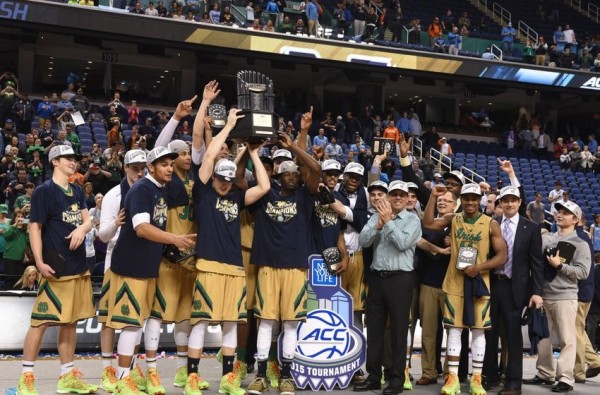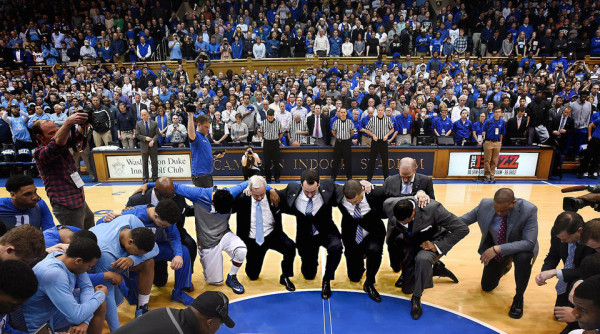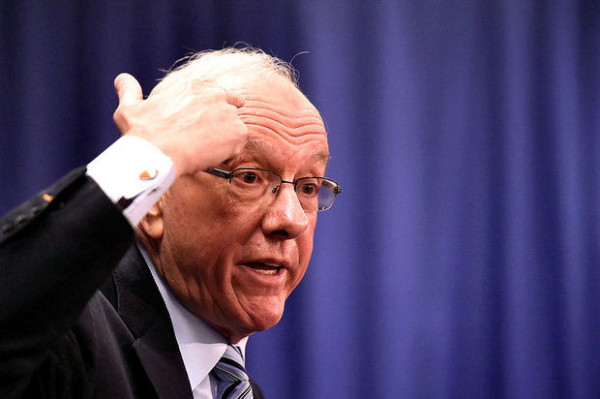2014-15: ACC Year in Review
Posted by Brad Jenkins (@bradjenk) on April 17th, 2015The 2014-15 season will go down as one of the most successful campaigns in the ACC’s long and illustrious history. It was the kind of year that commissioner John Swofford must have envisioned when the conference completed its last round of expansion. It was also important for the league to have this kind of performance after an extremely disappointing run last season, its first as a giant 15- team group featuring some of the biggest names in the sport. Before we put a bow on the season, let’s take a quick look at how the season played out with a review of some of the highlights and lowlights.
Highlights

Notre Dame celebrates its first ever conference tournament championship.
(Evan Pike/USA TODAY Sports)
Regular Season Excellence. The ACC began the year with four schools ranked in the preseason AP top 10 and the league maintained a strong presence at the top of the rankings all season long, finishing with five of the final poll’s top 17 teams. In addition to Duke’s fine year – which included Mike Krzyzewski’s 1,000th career win, Virginia was also a mainstay at the top of the rankings, getting off to a 19-0 start on the way to the Cavaliers’ second straight ACC regular season title. Perhaps the Cavaliers would have joined Duke in Indianapolis at the Final Four if not for an untimely late season injury to Justin Anderson. The ACC’s surprise team was clearly Notre Dame, as Mike Brey’s program won its first conference tournament in school history in only its second year as an ACC member. The Irish’s near-upset of undefeated Kentucky in the Elite Eight may have been the best game of the entire NCAA Tournament.
NCAA Tournament Performance. Duke’s fifth national championship headlined a banner year of postseason play for the league. It was the ACC’s sixth title in the last 15 years, and its 11th since 1982 — four more championships than any other conference. The Blue Devils also ended the league’s four-year Final Four drought, which had been the longest in ACC history. Duke’s Final Four wins over Michigan State and Wisconsin also extended the ACC’s dominance over the Big Ten on college basketball’s biggest stage — the league has now won 10 consecutive Final Four meetings between the two leagues. The ACC went an outstanding 17-5 in the Big Dance, the league’s most wins in a single NCAA Tournament, and only one win short of the Big East’s record (18) set back in 1985. Five ACC teams in the Sweet Sixteen represented another historical best for the conference, tying the Big East for the most ever by one league (2009). Had Notre Dame held on to beat Kentucky, the ACC would have been the league to beat all the other #1 seeds — N.C. State upset #1 seed Villanova in the Third Round, and Duke beat fellow #1 seed Wisconsin for the national title. Also noteworthy in this year’s postseason results was Miami’s NIT performance, as the Hurricanes lost an overtime championship game to Stanford despite playing without two injured starters.
Outstanding Players. Duke’s Jahlil Okafor became the first freshman to be named the ACC Player of the Year and was a consensus First Team All-American along with Notre Dame’s senior guard Jerian Grant. Four other league players were voted to various All-America teams: Virginia’s Malcolm Brogdon and Justin Anderson, Syracuse’s Rakeem Christmas, and Duke’s Quinn Cook.
Lowlights
NCAA Investigations. Two of the top programs in the league were beset by embarrassing scandals this season. Before the games even began, North Carolina announced the findings of a comprehensive independent investigation that revealed systematic academic fraud involving numerous past members of the basketball program. That report was soon followed by an announcement that NCAA gumshoes would return to Chapel Hill to see if any additional punishment is warranted. Expect the specter of possible sanctions and possibly even vacated wins and titles to be hanging over the Tar Heels and Roy Williams for a good while longer. Speaking of long investigations, the NCAA dropped the hammer on Jim Boeheim’s program in early March. Syracuse had already decided it would not participate in postseason play this season — an act of volition widely viewed as incredibly convenient given that the Orange probably were not going to be an NCAA Tourney team anyway.
Player Dismissals. Three high-profile players were kicked off their respective teams this season. In December, Florida State’s preseason all-ACC candidate Aaron Thomas was the first major dismissal as he was ruled ineligible for the spring semester. Near the end of January, Duke junior Rasheed Sulaimon became the first Blue Devil in the Coach K era to get kicked off the squad for what was called a failure to uphold the standards of the program. Finally, Louisville first suspended and later expelled point guard Chris Jones from the program amid assault charges that were made against him.
Passing of a Legend. If Everett Case is the Grandfather of the ACC, then Dean Smith is the unquestioned father of the league. The venerable former North Carolina head coach’s death in February cast a pall over the rest of the ACC season. Perhaps the most moving scene in all of college basketball this year was the tribute to Smith that was conducted before North Carolina’s first meeting of the year with archrival Duke, when players and coaches from both teams knelt together at midcourt in Cameron Indoor Stadium for a poignant moment of silence.

The tribute to Dean Smith before the Duke-Carolina game in Durham was the most moving moment of the ACC season. (Chuck Liddy/Raleigh News & Observer)
Best Conference Debate
All in all, the ACC made great strides in its quest to regain the unofficial title of the best conference in college basketball. Some will point to the league’s great postseason success as proof of its superiority over the Big 12, the darling of the computer ratings. Others will argue that the NCAA Tournament is too small of a sample size to provide a basis for making broad-brushed assumptions. There are flaws in both ways of thinking. Consider that the ACC’s spectacular Second Round performance (6-0) included four games that came down to the final possession. The Big 12, on the other hand, lost both of its games (Baylor and Iowa State) that finished at the very end. Such is the randomness of a single-elimination playoff system, but it can lead to fallacious judgments based on one made or missed jump shot. It is also totally inaccurate to say that the Big 12 was the best conference “all year long” because it resided at the top of all the computer rankings by March. You have to remember that conference ratings are established almost entirely (98%?) on interconference games played before January.
It is accurate to say that the Big 12 was the best league in pre-conference play but we have no metric that can yet tell us whether a conference as a whole gets better or worse during conference season. We know that teams all over the country drastically improve or regress after the new year, so it’s entirely reasonable to assume the same holds true for leagues as well. This information gap can lead to false assumptions. When Kansas State (8-10 in the league, #88 KenPom), as an example, went 5-5 against the Big 12’s top five teams, we were told that this was evidence that the Wildcats (and the Big 12) were a good team in a brutal conference. But maybe the opposite premise was true — that the better Big 12 teams actually weren’t as good as they seemed because they kept losing to such a mediocre team. On the other hand, when a Clemson team with a similar profile (8-10 ACC, #80 KenPom) went 0-6 against the ACC’s top five teams, we were told that this showed how soft the ACC’s middle was. But in reality, it may have instead been a case of just how strong the top of the league was. The question now becomes whether the ACC can follow up its impressive season with sustained excellence year after year. We’ll examine the prospects for the 2015-16 season on Monday.











































